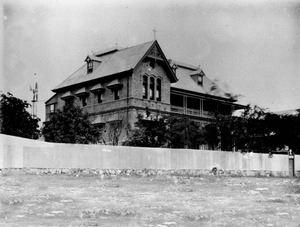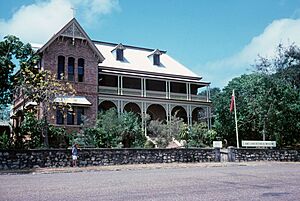Cooktown Museum facts for kids
Quick facts for kids Cooktown Museum |
|
|---|---|

James Cook Historical Museum, 2006
|
|
| Location | Furneaux Street, Cooktown, Shire of Cook, Queensland, Australia |
| Design period | 1870s–1890s (late 19th century) |
| Built | 1888–1889 |
| Architect | Francis Drummond Greville Stanley |
| Official name: James Cook Historical Museum, St Mary's Convent and School | |
| Type | State heritage (built) |
| Designated | 21 October 1992 |
| Reference no. | 600423 |
| Significant period | 1888–1941 (historical school/convent) 1970s–ongoing (historical museum) 1941–45 (historical US occ |
| Significant components | Kitchen/kitchen house, garden/grounds, school/school room |
| Builders | Hobbs & Carter |
| Lua error in Module:Location_map at line 420: attempt to index field 'wikibase' (a nil value). | |
The Cooktown Museum is a special building in Cooktown, Queensland, Australia. It used to be a convent and school called St Mary's. Now, it is a popular museum.
This historic building was designed by Francis Drummond Greville Stanley. It was built between 1888 and 1889 by Hobbs & Carter. The museum is listed on the Queensland Heritage Register. This means it is an important part of Queensland's history. It was added to the list on October 21, 1992. In December 2021, its name changed from James Cook Historical Museum to Cooktown Museum.
A Look Back: The Museum's History
This large, two-storey brick building was built as St Mary's Convent and School. It was completed in 1889. Bishop John Hutchinson had the idea for the school. He was the first leader of the Catholic Church in Cooktown. The building was designed by Francis Drummond Greville Stanley. He was a well-known architect in Queensland. Sisters of Mercy from Ireland came to teach at the school.
Cooktown's Early Days
In the 1880s, Cooktown was a very important town. It was the main port for far North Queensland. Bishop Hutchinson wanted to create a great school there. He imagined a place that offered excellent education. It would be for girls in the region. The school would teach both religious and academic subjects. It was planned to be a day school and a boarding school.
The Architect and Builders
The school was designed by FDG Stanley. He designed many important buildings in the late 1800s. He also designed other Catholic churches and schools. The company Hobbs & Carter built St Mary's Convent and School. They were from Brisbane. They also built the Cook Monument in Cooktown in 1887.
Bishop Hutchinson returned from Ireland in June 1888. He brought five Sisters of Mercy to teach. The building was not finished yet. But work continued quickly. The Sisters and students moved in by May 1889.
Building Details and Costs
Stanley's first plan was for a main brick building with two side wings. But only the main part and one wing were finished. This cost almost £5,000. They hoped to build the second wing later. However, this never happened.
The building was very impressive for Cooktown. It was even bigger than the Queensland National Bank building. The foundation was made of concrete. The base used local Cooktown granite. Most of the bricks came from Brisbane. Many skilled workers also came from Brisbane.
Inside the School
On the ground floor, there was a main entrance hall. To the right was a large dining room. This room was also used as the school chapel. To the left was a reception room for visitors. Behind these rooms were two classrooms. They could be divided by folding doors. The school hall was in the north wing. It was a very large room. The bathrooms were at the end of the hall.
A main staircase led to the upper floor. This floor had dormitories for boarding students. It also had rooms for the Sisters. There were more bathrooms upstairs. Boarding students used a separate staircase at the back. The kitchen and servant's room were in a separate building. It was connected by a covered walkway. The design was good for Cooktown's warm climate. Rooms were large and airy. There were deep verandahs at the front and back.
A Cooktown Landmark
The school was built on a hill. It had amazing views over the Endeavour River. By the 1890s, the building was a famous landmark. Journalists often wrote about it when visiting Cooktown.
Bishop Hutchinson put a lot of his own money into the school. He also borrowed from his family. But the local community also raised a lot of money. People understood the need for a good girls' school. Families of all faiths sent their daughters there. It was the first high school for girls in the area. It became known for its excellent music program. The famous singer Gladys Moncrieff studied there.
Changes Over Time
Cooktown became less important in the 1890s. This was because gold mining in the Palmer Goldfields slowed down. Bishop Hutchinson passed away in 1897. His successor, Bishop James Murray, helped pay off the school's debt. He did this by giving talks in the United States. In 1906, Bishop Murray moved to Cairns. Cairns had become the main port in North Queensland.
Even with Cooktown's decline, St Mary's School remained important. It was a key school for girls until the 1930s. A cyclone in January 1907 damaged the building. Part of the roof was removed. But it was repaired right away.
The boarding school closed in the 1930s. But day classes continued until 1941. During World War II, the United States military used the building.
Becoming a Museum
The building was given back to the Church in 1945. But the school did not reopen. The Sisters never returned. Another cyclone damaged the building in 1949. By 1969, it was in very bad condition. There were plans to tear it down.
But people protested. They wanted to save the building. So, it was given to the National Trust of Queensland. The plan was to restore it. It would then house the collection of the James Cook Historical Museum.
The new museum opened on April 22, 1970. Queen Elizabeth II opened it during her visit to Australia. This visit celebrated 200 years since Captain Cook explored the east coast. The National Trust still looks after the building today. It is a main tourist attraction in Cooktown. In the early 1970s, new parts were added to the back. These additions hold more museum displays.
The museum grounds are now the Joseph Banks Memorial Garden. It has about 40 types of plants. These plants were found by Joseph Banks and Dr Daniel Solander. They stayed at the Endeavour River in 1770. All 40 plants are unique to the Cooktown area.
What the Museum Looks Like
The Cooktown Museum building sits on a hill. It looks over the Endeavour River. It is made of red brick. Its style is called Victorian Gothic. The building has an L-shape. A section sticks out to the west on its north end. Brick decorations go around the building. They are below the windows on both floors.
The roof is steep. It is now made of corrugated iron. The original roof was different. The roof ends in a gable over the western part. It is a hipped shape at the south end. Some original decorations have been removed from the roof. Later, dormer windows were added. There are four on the east side, one on the north, and two on the west.
There are verandahs on the east and west sides. The front verandah (west) has paired cast-iron Corinthian columns. These columns divide it into five sections. Each section has decorative cast-iron brackets. The columns on the first floor are in a Doric style. They support the verandah roof. The back verandah (east) is now enclosed. But it still has its original single columns. It also has a cast-iron first-floor balustrade. There is a deep timbered valance on the ground floor.
The old single-storey brick kitchen building is still at the back. It is on the north side. New additions have been built next to it for the museum.
The western part of the building has three long, narrow windows. They are on both the ground and first floors. Above them is a round vent. On the north side, there are sets of four double-hung timber windows. They are evenly placed on both floors. These windows have hoods with scalloped edges.
The main timber doorway is in the center. It has side lights. Stone stairs lead up to it from the western verandah. Double-hung windows are on each side of this doorway. They have shallow arched tops and hood moulds.
The top of the western gable roof has cast-iron panels. These are between a timber support and a king post. The king post goes up to the roof and holds a cross.
Inside, the central hall has a beautiful timber staircase. Rooms of different sizes open off central hallways. This is true for both the ground and first floors. The rooms at the north end are now large museum display areas. The walls are plaster over brick. The ceilings are plaster with decorative moldings.
Why the Museum is Important
The Cooktown Museum is listed on the Queensland Heritage Register. This means it meets certain important standards.
Showing Queensland's History
The former St Mary's Convent and School was built in 1888–89. It shows how Cooktown grew and then declined. Cooktown was a key port for the Palmer River goldfields in the late 1800s.
Its construction shows how strong Cooktown's economy was in the late 1880s. It also shows the confidence people had in Cooktown's future. They believed it would be the main town and port of far North Queensland. Building the convent and school also shows how important education was. Especially religious education, which was seen as a "civilizing" influence in remote areas.
A Rare and Special Place
This building is special because it is rare. Few buildings of this size and detail were built in remote places like Cooktown. In the 1880s, Cooktown could only be reached by sea.
A Great Example of Its Kind
The former convent and school is an excellent example of a large brick building from the 1880s. It has many decorative details. It was designed to suit the tropical Cooktown climate. It worked well as both a convent and a school.
Beautiful and Important
The building is well cared for. It still looks beautiful. It adds a lot to the look of Cooktown. It is on a hill, visible from the sea. It has been a Cooktown landmark since it was built.
Connected to the Community
The museum has a strong connection to the people of Cooktown. It reminds them of the town's important past. This was clear when people protested its demolition in the 1960s. As the James Cook Historical Museum, it became a major tourist attraction.
Linked to Important People and Groups
The building is strongly linked to the Augustinian fathers. This includes Bishops Hutchinson and Murray. It is also linked to the Sisters of Mercy. They worked in Cooktown in the late 1800s and early 1900s. It also has a connection to the American military during World War II. Since 1970, it has been home to the James Cook Historical Museum collection. The Joseph Banks Memorial Garden is in the grounds. It honors the work of botanist Joseph Banks and Dr Solander. They spent seven weeks at the Endeavour River in 1770.



